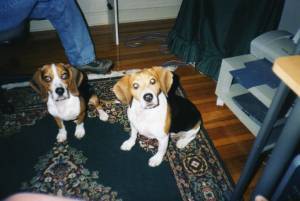The Big News of the Big Trip
When my husband, Bill, told me we were going to be moving to Germany, I wasn’t as excited as I could have been. Instead of thinking about all of the wonderful experiences we might have in Germany, I was thinking about our two beagles, Flea and MacGregor. My dogs are the closest thing I have to kids of my own and I worried about how they’d fare, stuck in plastic crates for over seven hours, riding in the baggage compartment. I found myself wishing my dogs were a little smaller so that I might have a prayer of taking them into the passenger compartment.
“Don’t worry!” Bill said, ” People take their animals to Europe all the time. They’ll be fine.”
I looked doubtfully at Flea, who at about eight years old is pretty set in his ways. He hates being locked in a crate. Suddenly, I was glad he was too big to ride in the passenger cabin. I knew he’d spend the whole flight howling in anguish, protesting being locked in his doggie jail instead of sitting on my lap. Luckily, MacGregor, my younger beagle, is much more laid back about being in a crate. He seems to view it as a safe haven. I worried a little less about him.
Like any good human beagle mommy, I started hunting the Internet for advice on how to get my two beagles overseas with a minimum of pain and fuss. I did find a few great articles that offered suggestions on how to make my dogs more comfortable during their flight. The first thing I needed were two plastic carriers that had holes on all four sides and met the standards set by the airline industry for safe pet travel. Off I went to PetSmart, where I was sure I’d find the perfect carrier. I didn’t bring my dogs with me on that trip, figuring they’d be too much to hold onto while I was looking at the crates. I knew each of my beagles weighed about 25 pounds and I figured I could guess at their height. I went to the crate section and started looking at the carriers, which all seemed either way too big or way too small. I knew that my dogs had to be able to stand up, lie down, and turn around in their crates, yet the crates also had to be within the size limits allowed by the airline.
Buying Carriers and Teaching My Dogs To Use Them
I saw a couple of crates that appeared to be about the right size and their labels said that they’d accomodate a dog who weighed around 25 pounds. The next size up I knew would be too large. I put the crates in my cart, eyeing them for just a moment before I checked out, wondering if they’d be too small. I finally decided I couldn’t go with the bigger ones, forked over $60 for the two carriers, took them home, and put them together.
Once I had my trusty dog carriers assembled, I figured it was time to have my beagles try them out. I looked at the dogs, wondering which one would be the more cooperative of the two. Flea tends to fight less than MacGregor does, but MacGregor is more comfortable in crates. To further coddle my dogs and gussy up their plastic pads, I bought them a couple of really soft pads to place on the floor of the crate. After letting them nap on the new pads for a couple of days, I put them in the crates. Then it was time for the moment of truth. I grabbed Flea and tried to get him to go in the crate. He was having none of it, so I grabbed MacGregor. Same result. Neither one of my dogs wanted any part of trying out their new carriers. I was left feeling like a frustrated failure.
What to do… what to do… I thought to myself. I consulted the Internet again. One article advised that I should feed my dogs in the crates and give them lots of treats there. As it so happens, my dog Flea happens to be pretty finicky about food, especially for a beagle. There are times when he actually turns down his morning rations, choosing to eat them later if MacGregor hasn’t already snarfed them down. But Flea does love his treats. Maybe I could get him to like the crate by giving him lots of dog cookies in there. I started hiding treats in the little carriers. MacGregor was a little more interested in finding them, but Flea got into the act before too long. Both dogs would sniff out the treats, but they’d only go into the carriers long enough to find and retrieve their doggie snacks. They enjoyed eating them outside the crates. September 16th was to be the big day. I fretted that my dogs wouldn’t get used to the crates in time for their flight to Germany.
As the day drew closer, I knew I had to get my dogs in the carriers, if only for a minute or two. I tried making them go in head first. That was not successful, since the dogs would brace with their front paws. Then I had the bright idea to back them into the crate. Jackpot! They still struggled a bit, but it was a lot easier to get them into the carriers. They wouldn’t cooperate by showing me that they could turn around, but I could see that though the crates looked a little cramped, the dogs seemed to fit reasonably well even if they didn’t look too happy.
I spent the summer trying to prepare my dogs for their big adventure. I worried about everything, especially after I made the mistake of reading a couple of horror stories about dogs overheating during flights and dying while trying to escape their carriers. I pictured my beloved beagles suffering that way, then realized that most airlines will not fly animals when the ground temperature is greater than 85 degrees fahrenheit. I felt a lot better when Bill told me that our flight would be departing in the evening, when the ground temperature was likely to be cooler. Even better, our flight was a direct one to Frankfurt. We had the option of catching a connecting flight to Stuttgart from Frankfurt, but figured our dogs would fare better if we just got them out of their crates as soon as possible and drove the rest of the way to our new city. In the long run, that turned out to be a wise course of action. The dogs got out of their crates, stretched their legs, and had the chance to relieve themselves before we started the two hour drive south and we didn’t have to worry about them making it on another flight.
One thing to be careful of when you fly with pets is quarantine requirements. It’s best to get a direct flight, if possible, but be especially mindful about layovers in other countries. Some countries require animals to be quarantined and will confiscate all animals that pass through, even if they’re in transit to another country.
Other Requirements For Moving To Germany
There were other things to think about besides the actual flight. I wanted to make sure my dogs would be welcome in Germany once we arrived there. Once again, the Internet came to the rescue. I consulted the German embassy’s Web site and found out the country’s requirements. First of all, several breeds are banned in Germany. It’s illegal to import pit bull terriers, American Staffordshire terriers, bull terriers, and certain dogs that are known to be bred for fighting. There are other breeds that are legal to own, but must pass a temperament test or be muzzled while in public. Complicating matters is the fact that the laws regarding restricted dog breeds are different for each of Germany’s 16 states. I breathed a sigh of relief when I saw that my beagles were not on any of the lists of banned or restricted breeds. I wasn’t surprised about that, of course, but I wanted to be certain.
Then I checked out the other requirements, realizing that I’d heard the Germans were big on paperwork and quite strict about adhering to the rules. I found out that Germany requires dogs to be vaccinated against rabies every year and does not recognize the three year vaccine that is available in the United States. Dogs coming to Germany must be vaccinated at least thirty days before their arrival in country. Our dogs were well within the three year vaccine requirement, but they would need a new rabies shot before we left the U.S. I got that taken care of about three months before we left.
All dogs must also be microchipped. Flea and MacGregor were both dogs that we got through a breed rescue. I knew that MacGregor was chipped, but Flea had managed to slip through the cracks, so I made an appointment to get him chipped as well. Finally, Germany requires all dogs to be examined by a veterinarian within ten days of arrival. The vet must complete a health form that is translated into German and the form must be stamped by the US Department of Agriculture. Fortunately, the vet check was no problem, since Bill is in the Army and all military vets are USDA certified.
Bill told the Army veterinarian who examined our dogs that we were a little worried about how they’d handle the flight. The vet laughed and said, “Aw, don’t worry about it. You take a Valium and they’ll be just fine.”
The Big Day!
On the big day, we loaded our beagles into the carriers and got them to Dulles Airport. A helpful baggage handler pointed us to the appropriate ticketing counter, where we paid about $200 for both of our beagles to ride as checked baggage on our United Airlines flight to Germany. Two friendly ticket agents had us fill out several forms, including instructions for their care.
We had put hamster bottles on the front of the carriers so that the dogs would have access to a water source if they wanted it. The ticket agents told us we also needed to supply food for the dogs. We had some packaged food for Flea and MacGregor, but no containers. The two cheery ladies who were helping us provided us with a couple of little plastic dishes, which they taped to the top of the crates along with the food. If I had to do it over again, I would have frozen the water in the hamster bottles so that it would melt during the course of the trip and not make as much of a mess in the crate.
The ticket agents directed us to the security line, where the crates were to be x-rayed. We took the dogs out while the crates went through the machine. After the carriers were cleared, the dogs went back in and the TSA wrapped security tape around the carriers. We waved goodbye to our doggies and then set about getting ourselves checked in for the trip.
Before we took off, an airline official gave us a couple of tags letting us know that Flea and MacGregor had made it safely aboard. Bill and I took a deep breath as we waited for the plane to take off for our new home.
Arrival in Germany
We arrived in Frankfurt, Germany at about 11:00am local time. Bill and I were very eager to be reunited with our dogs, knowing that they’d been locked in their carriers for over seven hours and were probably dying to pee. We wondered where we would need to go to find our beloved pets. Fortunately, that didn’t turn out to be a problem, for it wasn’t long before we heard Flea’s distinctive baying. He sounded distressed. Okay, he sounded pissed off more than anything else. We simply followed the sound until we found our two beagles in their crates being watched over by a couple of confused looking Germans.
Bill and I grabbed the crates and hustled over to the baggage claim. Flea was still howling, but MacGregor was very quiet and calm. A harried looking veterinary official asked me for our paperwork. I looked through our baggage and found it. She looked it over and it was all in order. Then she asked me to take the dogs out of thir crates so that she could check for their microchips. After ensuring that both dogs were properly chipped, she said we’d passed inspection. Before she left us, she warned us that we needed bigger carriers if we were planning to send our dogs back to the U.S. Apparently, the Germans are a lot stricter about carrier size than the Americans are.
Flea wanted no part of being put back in his crate. He howled in protest as we moved to the car rental area and we got lots of amused and annoyed looks from Germans who passed by. MacGregor, by contrast, was a perfect gentleman. I finally let Flea out of the carrier, marveling at the fact that in Germany, dogs are pretty much allowed everywhere.
Once we had a rental car, Bill and I pushed a cart loaded with all of our luggage and MacGregor. Flea was happy to saunter out of the airport on his own four legs. I think all four of us are thrilled to be past that part of our German adventure. The vet who had checked them out before we left the States turned out to be right about how our animals handled flying. They were fine, if not a bit thirsty and disoriented from the travel. In other words, they were absolutely no worse off than we were once we landed… and in fact, so far, they seem to be more welcome in Germany than we are!



